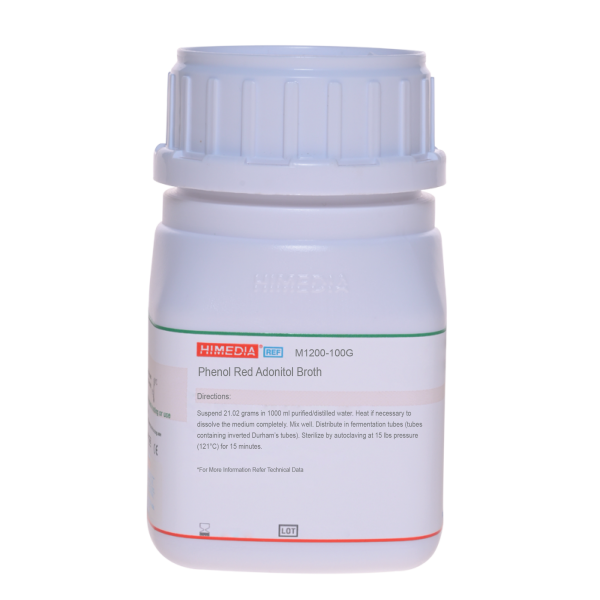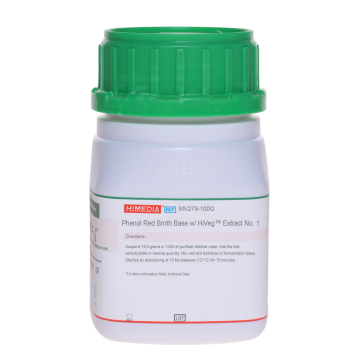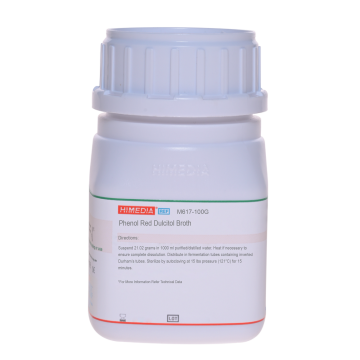 Your enquiry has been submitted
Your enquiry has been submitted
Phenol Red Adonitol Broth
Composition**
| Ingredients | Gms / Litre |
|---|---|
| Proteose peptone | 10.000 |
| Meat extract B # | 1.000 |
| Sodium chloride | 5.000 |
| Adonitol | 5.000 |
| Phenol red | 0.018 |
Final pH (at 25°C): 7.4±0.2
**Formula adjusted, standardized to suit performance parameters
# Equivalent to Beef extract B
Directions
Suspend 21.02 grams in 1000 ml distilled water and mix well. Heat if necessary to ensure complete solution. Distribute in fermentation tubes (tubes containing inverted Durham's tubes). Sterilize by autoclaving at 15 lbs pressure (121°C) for 15 minutes.
Principle And Interpretation
Phenol Red Broth Medium is formulated as per Vera (2) and is recommended to determine the fermentation reaction of carbohydrates for the differentiation of microorganisms (3, 4, 5). Phenol Red Broth Medium with various carbohydrates serves as a differential medium by aiding in differentiation of various species and genera by their ability to ferment the specific carbohydrate, with the production of acid or acid and gas (6). Phenol Red Adonitol Broth is used to study adonitol fermentation in various bacteria.
Proteose peptone and meat extract B serve as sources for carbon and nitrogen. Sodium chloride is the osmotic stabilizer. Phenol red is the pH indicator, which turns yellow at acidic pH i.e. on fermentation of adonitol. Gas formation is seen in Durhams tubes. All of the Enterobacteriaceae grow well in this medium. In addition to producing a pH colour shift, the production of mixed acids, notably butyric acids, often results in a pungent, foul odour from the culture medium (1).
Quality Control
Appearance: Light yellow to pink coloured homogeneous free flowing powder
Colour and Clarity of prepared medium: Red coloured clear solution without any precipitate
Reaction: Reaction of 2.1% w/v aqueous solution at 25°C. 7.4±0.2 pH : 7.4±0.2
pH: 7.20-7.60
Cultural Response
M1200: Cultural characteristics observed after an incubation at 35-37°C for 18-24 hours.
| Organism | Inoculum (CFU) | Growth | Acid production | Gas |
|---|---|---|---|---|
| Citrobacter freundii ATCC 8090 | 50-100 | luxuriant | Negative reaction, no colour change | Negative reaction |
| Escherichia coli ATCC 25922 | 50-100 | luxuriant | Negative reaction, no colour change | Negative reaction |
| Enterobacter aerogenes ATCC 13048 | 50-100 | luxuriant | Positive reaction, yellow colour | Positive reaction |
| Klebsiella pneumoniae ATCC 13883 | 50-100 | luxuriant | Positive reaction, yellow colour | Positive reaction |
| Proteus vulgaris ATCC 13315 | 50-100 | luxuriant | Negative reaction, no colour change | Negative reaction |
| Serratia marcescens ATCC 8100 | 50-00 | luxuriant | Negative reaction, no colour change | Negative reaction |
| Salmonella Typhi ATCC 6539 | 50-100 | luxuriant | Negative reaction, no colour change | Negative reaction |
| Salmonella Typhimurium ATCC 14028 | 50-100 | luxuriant | Negative reaction, no colour change | Negative reaction |
| Shigella flexneri ATCC 12022 | 50-100 | luxuriant | Negative reaction, no colour change | Negative reaction |
Storage and Shelf Life
Store below 30°C in tightly closed container and prepared medium at 2-8°C. Use before expiry date on the label.
Reference
- Koneman E. W., Allen S. D., Janda W.M., Schreckenberger P.C., Winn W.C. Jr., 1992, Colour Atlas and Textbook of Diagnostic Microbiology, 4th Ed., J. B. Lippinccott Company
- Vera H. D., 1950, Am. J. Public Health, 40, 1267
- MacFaddin J. F., 1985, Media for Isolation-Cultivation-Identification -Maintenanceof Medical Bacteria, Vol. I, Williams and Wilkins, Baltimore.
- Finegold S. M. and Baron E. J., 1986, Bailey and Scotts Diagnostic Microbiology, 7th Ed., The C.V. Mosby Co., St. Louis.
- Ewing W. H., 1986, Edwards and Ewings Identification of Enterobacteriaceae, 4th ed., Elsevier Science Publishing Co., Inc., New York.
- MacFaddin J. F., 2000, Biochemical tests for Identification of Medical Bacteria, 3rd edi., Lippincott, Williams and Wilkins, Baltimore.
| Product Name | Phenol Red Adonitol Broth |
|---|---|
| SKU | M1200 |
| Product Type | Regular |
| Physical Form | Powder |
| Origin | Animal |
| Packaging type | HDPE |
| References | 1. Koneman E. W., Allen S. D., Janda W.M., Schreckenberger P.C., Winn W.C. Jr., 1992, Colour Atlas and Textbook of Diagnostic Microbiology, 4th Ed., J. B. Lippinccott Company |
| Customized Product Available | No |










